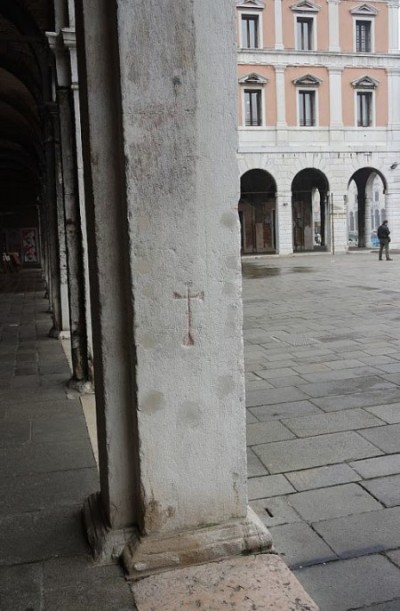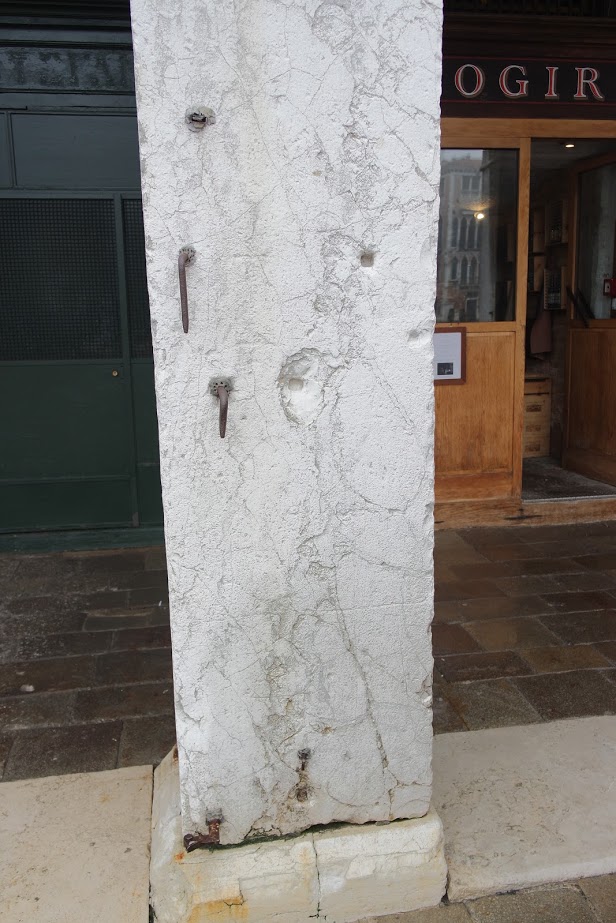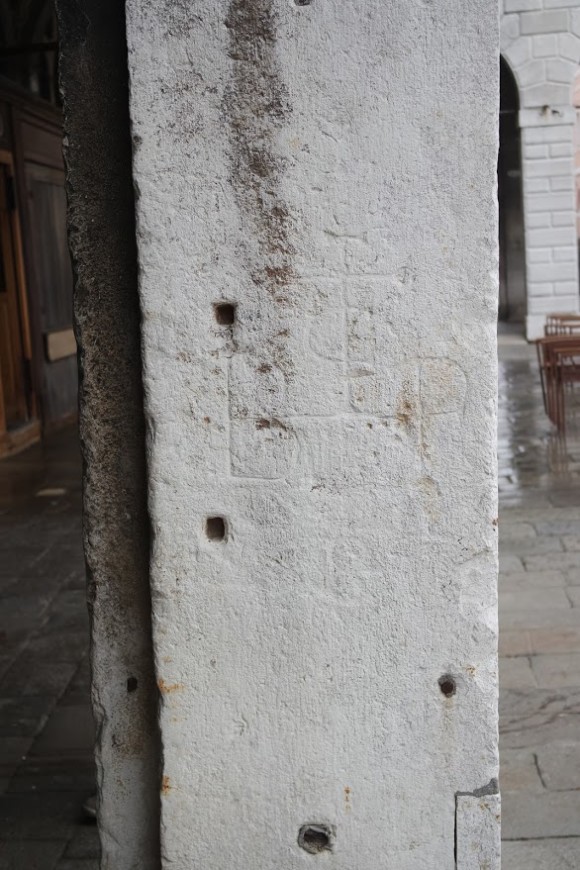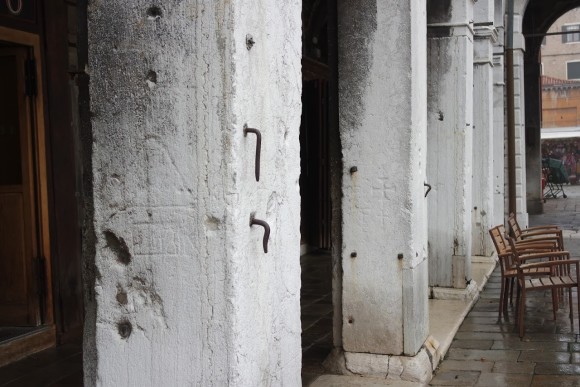As we were wandering around the Rialto area examining Fascist mottoes, we also discovered an astonishing assortment of signs, symbols, inscriptions, and other indications of life from the past that are just sitting out there in the rain and wind deteriorating with nary a squeak from themselves, much less anybody else.
Here are some of the things we found. (Well — “found” isn’t quite right. They were hardly lost. But they do seem to be in the process of becoming lost.) I’m not saying we’re the only people who have ever noticed these, so no prizes or props to us. But it seems clear that nobody at the Superintendency of Fine Arts or Beni Culturali or any other government agency tasked with paying attention to the city’s treasures, monuments, or general aesthetic or historical elements has given them any thought whatsoever. I’m all for restoring paintings by Titian, but I’m also for respecting and even defending these literal voices which have been silenced because they’re not famous.
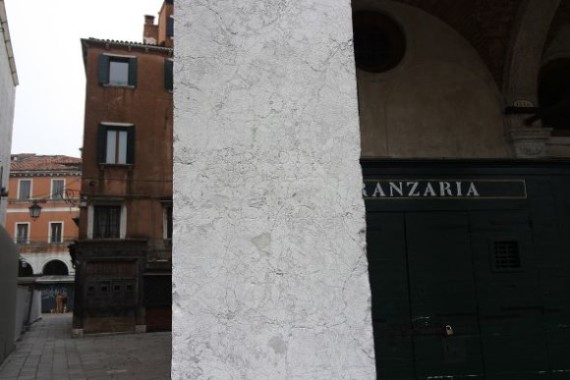
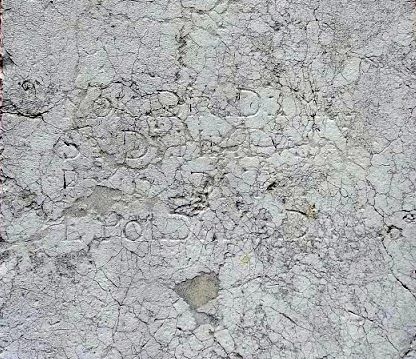
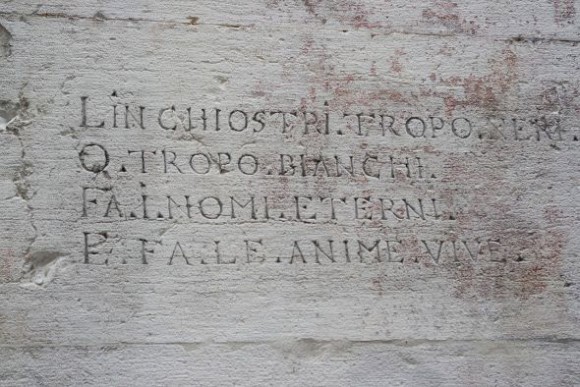
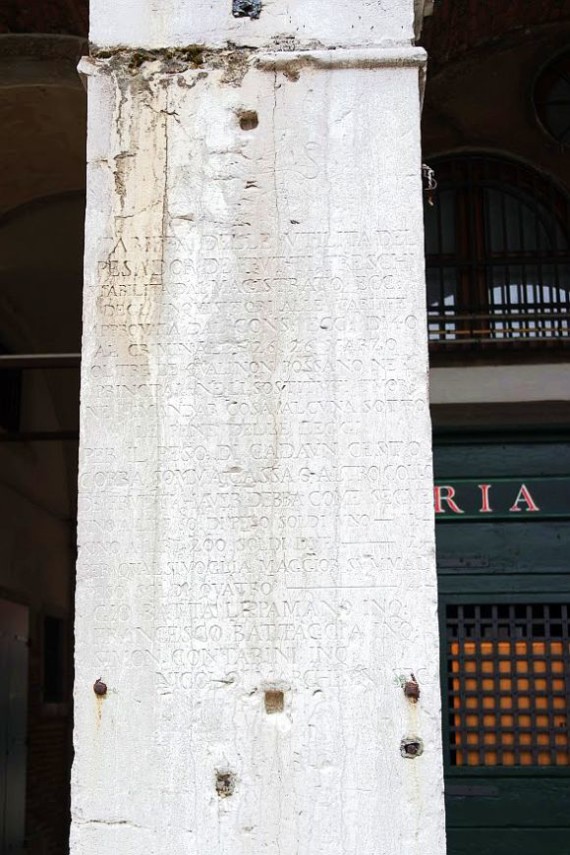
The proclamation on this column reads as follows (translation below by me):
TARIFFA DELLE VTILITA DEL PESADOR DE FRUTTI FRESCHI STABILITA DAL MAGISTRATO ECC. DEGLI INQUISATORI ALLE TARIFFE APPROVATA DAL CONS. ECC. DI 40 AL CRIMINAL 1726 26 MARZO OLTRE DE QUALI NON POSSANO NE PRINCIPAL NE LI SOSTITUTI TVOR (prendere) NE MANDAR COSA ALCUNA SOTTO LE PENE DELLE LEGGI PER IL PESO DI CADAUN CESTO CORBA (illegible) CASSA O ALTRO COLLO DE ERVETTA HAVER DEBBA COME SEGVE SINO A LIRE 60 DI PESO SOLDI VNO — 1 SINO AL 200 SOLDI DVE — 2 PER QVALSIVOGLIA MAGGIOR SVMMA IL PESO SOLDI QVATTRO — 4 GIOBATTA LIPPAMANO INQ FRANCESCO BATTAGGIA INQ SIMON CONTARINI INQ NICOLO MARCH (?) SEC
THE TARIFF OF THE COMMODITIES OF THE WEIGHMASTER (I invented this word; the pesador was the official weigher) OF FRESH FRUITS ESTABLISHED BY THE MOST EXCELLENT MAGISTRACY OF THE INQUISITORS OF THE TARIFFS APPROVED BY THE MOST EXCELLENT COUNCIL OF 40 OF THE CRIMINAL (the “Quarantia,” or Council of 40, was the supreme government office concerned with financial planning and the Mint; it was divided into three sections, and the “Criminal” was responsible for capital crimes and, as needed, the death penalty) 1726 26 MARCH BEYOND WHICH NEITHER PRINCIPALS OR THEIR SUBSTITUTES MAY TAKE (“tor” or “tuor” is still the common Venetian word for “take”) OR SEND ANY SORT OF THING UNDER PAIN OF THE LAWS FOR THE WEIGHT OF EACH BASKET CORBA (a corba was a long, large basket made of wicker or woven chestnut twigs, usually with handles) CHEST OR OTHER LARGE CONTAINER OF GREEN LEAFY VEGETABLES HAVING TO PAY AS FOLLOWS UP TO 60 LIRE OF WEIGHT ONE SOLDO – UP TO 200 TWO SOLDI – FOR WHATEVER AMOUNT ABOVE THAT FOUR SOLDI GIOBATTA LIPPAMANO INQUISITOR FRANCESCO BATTAGGIA INQUISITOR SIMON CONTARINI INQUISITOR NICOLO MARCH(?) SECRETARY.
I have only translated that bit about money and weight as literally as I can, but you clearly have to be in either the selling or the weighing business to be able to interpret what they mean. Please overlook this for now.
“Erbette,” literally “herbs,” refers to planty foods such as spinach, chicory, chard, etc. The indefatigable Tassini notes, in “Curiosita’ Veneziane,” that the Erbaria at Rialto was the place where such plants and fruits from the nearby islands and mainland were sold. I translate: “It existed in the 1300s, and in 1398 was paved with stone, while before it had been paved with wood. The business (“art”) of the vegetable-sellers was a ‘column’ of the Fruit-sellers guild, and in 1773 had 122 shops, 11 closed places (I am guessing those were the gated and locked storerooms), and 89 “sendings.” (Consignments?). He continues, “In 1581 this ‘art’ was allowed to have its altar in the church of SS. Filippo and Giacomo (church torn down by Napoleon) which had belonged first to the Bargemen, and also served for the use of the Linen-workers.”
